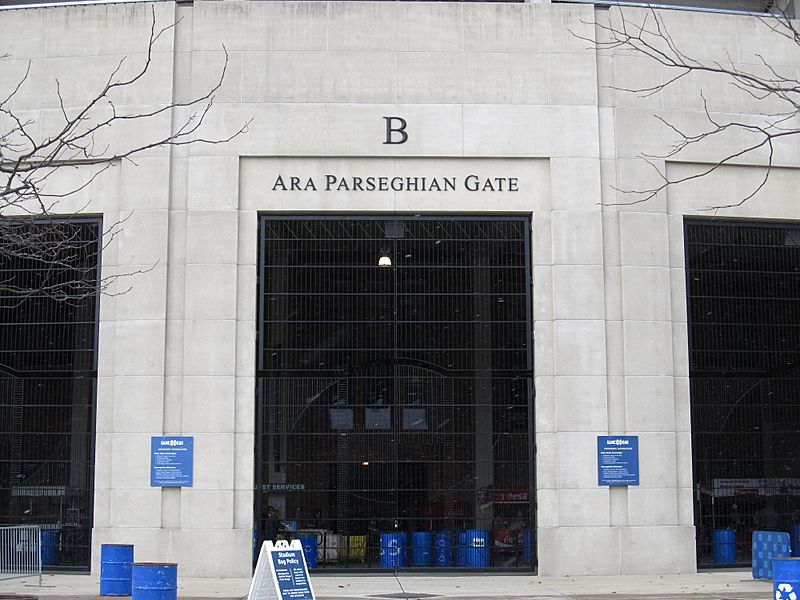Image: Ara Parseghian Gate, Notre Dame Stadium, University of Notre Dame, South Bend, Indiana (11045765074)

Description: Notre Dame Stadium is the home football stadium for the University of Notre Dame Fighting Irish football team. Located on the southeast part of the university's campus in Notre Dame, Indiana and with a seating capacity of 80,795, Notre Dame Stadium is one of the most renowned venues in college football. The Sporting News ranks Notre Dame Stadium as # 2 on its list of "College Football Cathedrals". With no JumboTron and just two modest scoreboards, the stadium experience evokes a more traditional feel. Notre Dame Stadium is used for football related activities and for Commencement (since 2010). <a href="http://en.wikipedia.org/wiki/Fighting_Irish_football" rel="nofollow">en.wikipedia.org/wiki/Fighting_Irish_football</a> Notre Dame Stadium is the home football stadium for the University of Notre Dame Fighting Irish football team. The stadium is located on the campus of the University of Notre Dame in Notre Dame, Indiana, just north of the city of South Bend. Opened in 1930, the stadium seating capacity was nearly 60,000 for decades. More than 21,000 seats were added for the 1997 season, which increased the capacity to over 80,000. The stadium opened its gates in 1930, replacing the old stadium Cartier Field. Total cost of construction was more than $750,000. The original seating capacity was 54,000. Head coach Knute Rockne played a key role in its design, keeping the space between the playing field and the stands to a minimum. The stadium is patterned, on a smaller scale, after Michigan Stadium, the main difference being the tunnel location. In 1929 plans were started by Osborn Engineering of Cleveland, Ohio. They were selected for their experience in designing Yankee Stadium and Fenway Park. The stadium is known for its view of "Touchdown Jesus", a nickname given to the large mural entitled The Word of Life by Millard Sheets of the resurrected Jesus. Installed in 1964 on the Hesburgh Library, the mosaic wall looms over the stadium, mirroring the raised arms of a referee signifying a touchdown. The expansion of the stadium in the late 1990s partially obscured the view of the mural from the playing field. Since 1966, attendance figures have been based on paid admissions with a fixed number of tickets available, accounting for the familiar 59,075 figure through the 1996 season. Until Ara Parseghian arrived as coach at Notre Dame in 1964, sellouts were not the norm. Since then, tickets to a Notre Dame football game have been notoriously hard to come by. As of the conclusion of the 2010 season, there have been 219 consecutive sellouts at Notre Dame Stadium, and 264 sellouts in the past 265 games dating back to 1964. <a href="http://en.wikipedia.org/wiki/Notre_Dame_Stadium" rel="nofollow">en.wikipedia.org/wiki/Notre_Dame_Stadium</a> <a href="http://en.wikipedia.org/wiki/Wikipedia:Text_of_Creative_Commons_Attribution-ShareAlike_3.0_Unported_License" rel="nofollow">en.wikipedia.org/wiki/Wikipedia:Text_of_Creative_Commons_...</a>
Title: Ara Parseghian Gate, Notre Dame Stadium, University of Notre Dame, South Bend, Indiana (11045765074)
Credit: Ara Parseghian Gate, Notre Dame Stadium, University of Notre Dame, South Bend, Indiana
Author: Ken Lund from Reno, Nevada, USA
Usage Terms: Creative Commons Attribution-Share Alike 2.0
License: CC BY-SA 2.0
License Link: https://creativecommons.org/licenses/by-sa/2.0 CC BY-SA 2.0 Creative Commons Attribution-Share Alike 2.0
Attribution Required?: Yes
Image usage
The following page links to this image:

